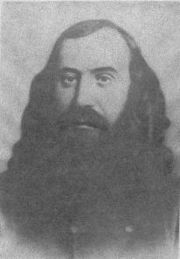
Eftimie Murgu
Encyclopedia

Romania
Romania is a country located at the crossroads of Central and Southeastern Europe, on the Lower Danube, within and outside the Carpathian arch, bordering on the Black Sea...
n politician who took part in the 1848 Revolutions.
He was born in Rudăria (today Eftimie Murgu, Caraş-Severin
Eftimie Murgu, Caras-Severin
Eftimie Murgu is a commune in Caraş-Severin County, western Romania, with a population of 1,822 people. It is composed of a single village, Eftimie Murgu.-References:...
) to Samu Murgu, an officer in the Imperial Army and Cumbria Murgu (née Pungilă). He studied in Old Slavonic
Old Slavonic
Old Slavonic may refer to:*Old Church Slavonic language*Common Slavonic language...
at the school of his village, continuing in Caransebeş
Caransebes
Caransebeş is a city in Caraş-Severin County, part of the Banat region in southwestern Romania. It is located at the confluence of the river Timiş with the river Sebeş, the latter coming from the Ţarcu Mountains. To the west, it is in direct contact with the Banat hills...
and then he studied Philosophy at the University of Szeged
University of Szeged
The University of Szeged is one of Hungary's most distinguished universities, and is among the most prominent higher education institutions in Central Europe...
, graduating in 1827. In 1830, he graduated from the University of Pest and in 1834, he obtained a PhD in Universal Law
Universal law
In law and ethics, universal law or universal principle refers as concepts of legal legitimacy actions, whereby those principles and rules for governing human beings' conduct which are most universal in their acceptability, their applicability, translation, and philosophical basis, are therefore...
, from the same university. Murgu joined a dispute with Sava Tököly on the Origin of the Romanians, publishing in Buda, in 1830, a work named Widerlegung ("The Rebuttal").
In 1834, he moved to Iaşi
Iasi
Iași is the second most populous city and a municipality in Romania. Located in the historical Moldavia region, Iași has traditionally been one of the leading centres of Romanian social, cultural, academic and artistic life...
, in Moldavia
Moldavia
Moldavia is a geographic and historical region and former principality in Eastern Europe, corresponding to the territory between the Eastern Carpathians and the Dniester river...
, where he opened the first philosophy course at the Academia Mihăileană
Academia Mihaileana
Academia Mihăileană was an institution of higher learning based in Iași, Moldavia, and active in the first part of the 19th century. Like other Eastern Europeean institutions of its kind, it was both a high school and a higher learning institute, housing several faculties.-History:Academia...
. In 1837, he moved to Wallachia after a conflict with Prince Mihail Sturdza
Mihail Sturdza
Mihail Sturdza was a prince of Moldavia from 1834 to 1849. A man of liberal education, he established the Mihaileana Academy, a kind of university, in Iaşi. He brought scholars from foreign countries to act as teachers, and gave a very powerful stimulus to the educational development of the...
. In Bucharest, he was named professor of logic and Roman Law at Colegiul Sfântul Sava. He was a member of the Wallachian revolutionary movement, but the plot was revealed and he was arrested and expelled.
In the Banat
Banat
The Banat is a geographical and historical region in Central Europe currently divided between three countries: the eastern part lies in western Romania , the western part in northeastern Serbia , and a small...
, he militated for national and social reforms, suggesting even a union with Wallachia, but he was arrested in March 1845, being freed only 3 years later, on 9 April 1848.
Murgu was elected a deputy to the Hungarian Parliamentand tried to establish a Romanian army in the Banat. He participated to the Revolutions of 1848 in the Habsburg areas
Revolutions of 1848 in the Habsburg areas
From March 1848 through July 1849, the Habsburg Austrian Empire was threatened by revolutionary movements. Much of the revolutionary activity was of a nationalist character: the empire, ruled from Vienna, included Austrian Germans, Hungarians, Slovenes, Poles, Czechs, Slovaks, Ruthenians,...
, being arrested in September 1849 and in October 1851, he was sentenced to death, but his sentence was reduced to four years in prison and two years later, in 1853, he was freed.
He died in Buda
Buda
For detailed information see: History of Buda CastleBuda is the western part of the Hungarian capital Budapest on the west bank of the Danube. The name Buda takes its name from the name of Bleda the Hun ruler, whose name is also Buda in Hungarian.Buda comprises about one-third of Budapest's...
, where he was buried in the Kerepesi Cemetery
Kerepesi Cemetery
Kerepesi Cemetery is the most famous cemetery in Budapest...
, his grave being moved in 1932 to the chapel of the Lugoj Cemetery.

